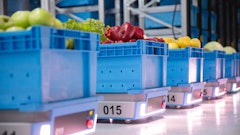
At Food Logistics, a considerable amount of our editorial coverage is devoted to the transportation piece of the supply chain, primarily road and to a lesser extent rail. This year we’ve made a concentrated effort to include an equally important—and growing—transportation mode: ocean.
‘Growing’ may in fact be an understatement. In May, the U.S. Department of Agriculture’s Economic Research Service and Foreign Agricultural Service upwardly revised its forecasts for imports and exports of U.S. farm goods to record breaking levels for FY 2014. All told, exports of U.S. agricultural goods is likely to reach $149.5 billion, while imports too are expected to hit a record high $110.5 billion.
Most of these agricultural imports/exports are moving by ocean carriers through a growing number of U.S. seaports, and this is where the story really gets interesting.
In the past few years we’ve seen a considerable amount of refrigerated food shipments migrate from specialized carriers to containerized carriers. There are several reasons for this shift, including greater overseas demand for fresh/frozen food, lack of capacity and ports of call from specialized reefer carriers, and technology advancements in refrigeration and controlled atmosphere to support a global cold chain.
Likewise, as more agriculture shipments move via containerized vessels, the number of seaports handling food-related shipments is changing and diversifying. Major box ports in the U.S. are seeing an uptick in food-related cargoes, both dry and refrigerated. Many are adding more reefer plugs to accommodate these shipments, while other infrastructure enhancements at or near the ports, such as more cold storage capacity, USDA and CBP inspection services, overweight container corridors, on-dock rail and other features are creating additional opportunities for shippers.
Meanwhile, niche ports with a long history of handling food shipments, whether bulk, breakbulk or containerized, are also seeing more business due to the overall increase in imports/exports.
This month’s cover story profiles some of the key U.S. ports in the global food supply chain, along with the top import/export commodities handled by each port and foreign source- and consumer-markets involved in the trade.
Going forward, we will continue to expand our coverage of this dynamic sector within the global food supply chain.
Another exciting change is closer to home. Recently, Food Logistics and our sister publication, Supply & Demand Chain Executive, were purchased by a new media company, AC Business Media (www.acbusinessmedia.com). This next chapter holds immense potential for our publications and audience and we are all looking ahead with enthusiasm.
Enjoy the read.

























